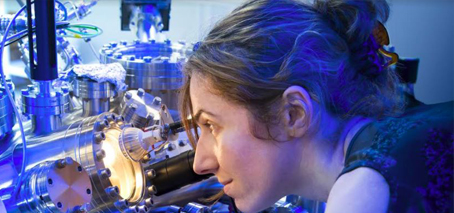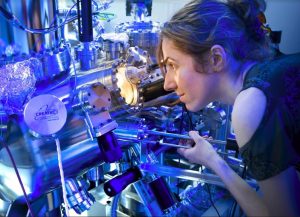New materials inspired by nature could be key to future electronics
Self-assembled nanostructures have atomically-precise structure and tailored electronic properties

Scanning tunneling microscope image of singly metalated TPPT
Bio organisms are the most-complex machines we know, and are capable of achieving demanding functions with great efficiency.
A common theme in these bio-machines is that everything important happens at the level of single molecules – that is, at the nanoscale.
The functionality of these bio-systems relies on self-assembly – that is, molecules interacting precisely and selectively with each other to form well-defined structures. A well-known example of this phenomenon is the double-helix structure of DNA.
Now, inspired by self-assembling bio-systems, an international group of scientists including FLEET physicists has created a new, carbon-based, self-assembled nanomaterial, which could be key to new photovoltaic and catalysis technologies.
Using self-assembly the researchers were able to engineer, with atomic-scale precision, a new 1D nanostructure composed of organic (carbon-based) molecules and iron atoms.
The findings are described in two studies published this month in Nature Communications and ACS Nano.
Atomic-scale precision via self-assembly: a pathway to functionality
“Fabricating nanomaterials by controlling the position of single atoms and molecules one at a time is very tedious, if not impossible,” says lead scientist Dr Agustin Schiffrin, Senior Lecturer at Monash University and FLEET Chief Investigator.
“Instead, we can create atomically-precise structures via self-assembly, by choosing the right molecules, atoms and preparation conditions.”
“This has the benefit that no external intervention is required,” explains Dr Schiffrin.
Such self-assembly capability comes from using organic (that is, carbon-based) molecules as building nano-units.
The shape, size and interacting functional groups of these organic molecules can be tuned in an almost infinite number of ways using organic synthetic chemistry.
Control of interactions between molecules leads to creation of the desired, well-defined nanostructure, similarly to the way interactions between nucleic acids in DNA give rise to the double-helix.
“We can thus build materials with a very precise, engineered structure, which results in the material having the desired electronic properties,” says co-author Marina Castelli, a PhD student within Monash University’s School of Physics and Astronomy.
“Just as the functions of bio-organisms depend on nano-scale interactions, the physical and electronic properties of these new materials come from their structure at a single-molecule level,” explains Monash Research Fellow Dr Cornelius Krull.
Bottom-up beats top-down
Conventional methods for material nanofabrication, such as lithography, rely on ‘top-down’ approaches, with materials patterned by removal of matter. Such methods are limited to resolutions of the order of 1 nanometre at best.
Instead, ‘bottom-up’ methods can allow for sub-nanometre patterning resolution, with the potential for a higher level of control and efficiency of electronic properties.
Moreover, applying ‘bottom-up’ synthesis approaches with a surface as a substrate allows for nanostructures with properties that cannot be achieved via conventional synthetic methods.
Nanomaterials based on metal-organic molecular complexes allow for a vast range of useful functionalities, both technological and biological, from catalysis to photovoltaics to gas sensing and storage.
In these systems, the atomic-scale morphology and electronic configuration of the metal-organic coordination motif play a crucial role, dictating their overall electronic and chemical properties.
The two studies

On-surface 1D nanostructure based on a trinuclear metal-organic coordination motif: the local electronic configuration at the metal centre holds promise for novel functionalities in optoelectronics and catalysis.
Examining electronic properties, potential for optoelectronics The paper Designing Optoelectronic Properties by On-Surface Synthesis: Formation and Electronic Structure of an Iron-Terpyridine Macromolecular Complex, published in ACS Nano, describes energy- and spatial-dependence of the electronic states (occupied and unoccupied) of the 1D iron-based metal-organic nanostructure, in an energy range near the Fermi level, which can be useful for optoelectronic applications such as photovoltaics, photo-catalysis and light-emitting devices.
Studying structure and chemistry at the single-atom level The paper Iron-based trinuclear metal-organic nanostructures on a surface with local charge accumulation, published in Nature Communications, describes at an atomic-scale the intramolecular structure and charge distribution of the nontrivial iron-molecule coordination motif, useful for catalysis applications.
Discover the science behind the paper in this research blog by Dr Shiffrin.
Collaboration
The studies represent a successful collaboration between FLEET and Monash University researchers and scientists from the University of British Colombia and the Czech Academy of Sciences (see the papers for full list of authors and affiliations).
FLEET Chief Investigator Professor Nikhil Medhekar led the Monash Engineering group who did part of the theoretical work behind the study, while FLEET partner organisation the Australian Synchrotron was also involved in characterisation of the resulting structures.
Novel materials and FLEET

Atomic manipulation As an alternative to programmed self-assembly of molecules, Monash researchers can actually place individual atoms. For example, this ‘microbranding’ project creates the FLEET logo from 42 individual iron atoms.
These studies demonstrate that supramolecular self-assembly and metal-organic compounds can be beneficial for the synthesis of novel nanomaterials with tailored and enhanced electronic properties.
Such materials are relevant for the goals of FLEET, which is an Australian Research Council Centre of Excellence.
The Centre for Future Low-Energy Electronics Technologies (FLEET) brings together over a hundred Australian and international experts, with the shared mission to develop a new generation of ultra-low energy electronics.
The impetus behind such work is the increasing challenge of energy used in computation, which uses 5–8% of global electricity and is doubling every decade.
More information
- Study contact Dr Agustin Shiffrin agustin.schiffrin@monash.edu
- FLEET contact Errol Hunt media@FLEET.org.au
- Visit FLEET.org.au
- Follow @FLEETCentre
- Watch Future solutions to computation energy use
- Subscribe FLEET.org.au/news




